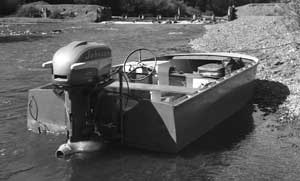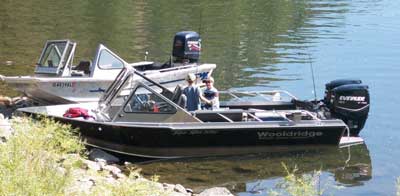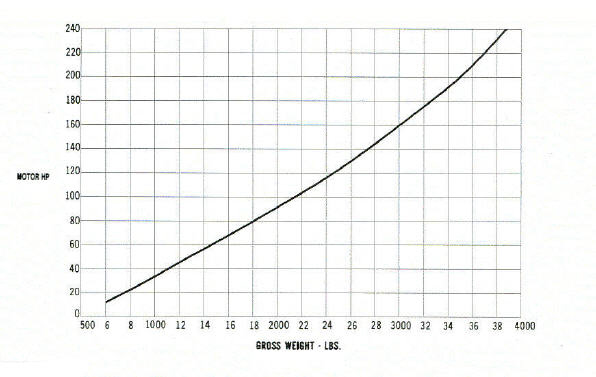 Combining the correct outboard power and boat design is the “secret” of successfully using an outboard jet to run in shallow water. After reading this information, please read the “Outboard Jets” brochure. These two pieces of information will assist you in selecting the best combination for your needs, thereby giving you the advantages of outboard power for shallow water use.
Combining the correct outboard power and boat design is the “secret” of successfully using an outboard jet to run in shallow water. After reading this information, please read the “Outboard Jets” brochure. These two pieces of information will assist you in selecting the best combination for your needs, thereby giving you the advantages of outboard power for shallow water use.
Most important is the boat. Keep it light as possible since, unlike a propeller drive, you can’t change to a lower pitch jet drive impeller to increase load capability.
Aluminum is usually the material of choice. It is light, tough and easy to form in the proper configuration. For outboard jets, the minimum recommended bottom thickness is .100 Gauge but thicker gauge or UHMW reinforcement can be useful in treacherous waters. Just be mindful about weight.
The size and shape of the bottom is very important. The object is to ride on top of the water, which requires a good planing surface, and to float as shallow as possible when shut down. Bottom should be at least 48 inches wide and boat length at least 14 feet long.
Air entering the jet drive causes slippage, so the boat bottom needs to supply solid water, free of air, to the jet drive intake.
 No one boat can satisfy every need, so choices must be made. With this thought in mind, some pros and cons of various boat types are noted below.
No one boat can satisfy every need, so choices must be made. With this thought in mind, some pros and cons of various boat types are noted below.
A flat bottom boat runs shallower than a vee bottom, but slides on the turns more. A vee bottom splits off air bubbles before they reach the jet intake. A flat bottom carries bubbles straight back.
The boat on the inside page of the brochure is an aluminum flat bottom with a 48 inch (4 ft.) bottom (45HP) and 14 ft. overall. This design works well, but will ingest some air when running with the wind in a chop. This can be helped by the use of intake fin side skirts.
A slight V of 6-10 degrees dead rise will enhance jet boat handling. Deep vee is not desirable for the Outboard Jet, not just because of increased draft and drag, But because the Outboard Jet needs a flat apron of water about 10” wide leaving the hull on which to set the leading edge of the jet intake, to minimize air intake and frontal drag. The dead rise should be fairly constant and not increase to a deep forefoot at the bow. A deep forefoot can cause spinout on a sharp turn.
Keels can be a problem, introducing air into the jet intake. Center keels vary in size and may introduce air. If this is suspected, the keel should be removed 2-3 feet forward of the transom. Other keel arrangements which tend to funnel air to the jet intake should be avoided.
The chines of the boat, where the sides meet the bottom, should be sharp. Round chimes tend to suck the boat down in the water and cause drag.
A properly designed tunnel, combined with a slight V bottom hull can greatly enhance jet boat performance. It should raise the motor 2-3 inches and place the heel of the jet intake flush or slightly above the bottom of the boat. A jet tunnel doesn’t work well with a flat bottom boat due to air ingestion. It’s imperative that the hull is designed correctly with the tunnel for the boat to operate properly.
The tunnel needs to be just large enough to feed the jet drive its water requirements. A tunnel that is longer, wider or deeper than necessary wastes power in lifting excess water, tends to suck the stern down when planing and sits deeper in the water at rest due to lost buoyancy.
The top of the tunnel width should be about 1 ¾ times the width of the jet drive water intake. The tunnel length doesn’t have to be longer than about 2 ½ times the water intake width.
Inflatables are the newest addition to the Outboard Jet Boat Family. Rigid Hull Inflatables have been on the market for decades but in recent years new stow-and-go inflatables specifically designed to run the Outboard Jet have hit the market. These new inflatables feature flat bottoms and tunnels in some cases. Once deflated, they can be stowed in the trunk on a car.
A rigid hull inflatable on the other hand cannot be folded to fit inside your car but steers better and provides solid water to the intake. Unfortunately, the hulls presently available have more than 10 degrees of deadrise.
A rigid hull inflatable on the other hand can’t be folded to fit inside your car, but steers better and provides solid water to the intake. Unfortunately, the hulls presently available have more than 10 degrees of dead rise.
Pontoon boats don’t provide a defined height apron of water ahead of the jet intake. The water level between the pontoons varies with speed and load carried. It’s necessary to build an inclined plane ahead of the jet intake attached to the motor mount, about 16” wide inclined at about 15 degrees with the leading edge above water level, fully loaded at rest, trailing edge lined up with the leading edge of the jet intake.
So much for boats, now about power.
There is about a 30% power loss when converting to our jet drive. A suitable outboard jet boat carrying an average load will provide about 80% of propeller speeds. It’s important to decide what load you want to carry how many people, gear, fuel, etc. and add the weight of the boat, motor and battery. Look up this gross weight on the chart below, or in the Outboard Jets brochure, to determine the minimum HP you need. The chart HP is power head horsepower.

It’s important that the boat-motor combination plane the boat quickly. Planing would normally be in the mid 20 MPH range and up. This is necessary for optimum jet performance and shallow water running. At low RPM, when the boat is not planing, you would need about 12 inches of clearance between the bottom of the jet and river bed to maneuver.
If at all possible, please, before you buy an outboard jet boat, go for a ride and look for these characteristics. Does the boat plane quickly and not cavitate easily (listen to the motor for the change in RPM’s) a destructive and negative performance trait. Will the boat maneuver through obstacles typically found in your environment without breaking loose or skating? Is handling predictable? Poor performance will show up in a jet boat taking a long time to get up on a plane, breaking loose early in cornering and cavitation.
The advantages of Outboard Jet boat include maximum space inside the boat while still having the ability to operate in less than 6” of water, relative ease of cleaning out a clogged pump and adjustment for wear on the impeller and intake liner.
So select a suitable boat with sufficient HP to handle your total weight, then enjoy fishing and hunting in areas you couldn’t reach before.